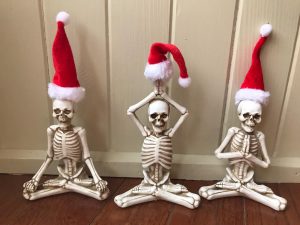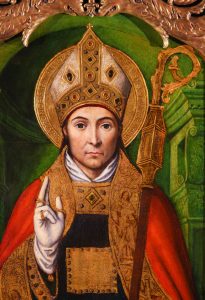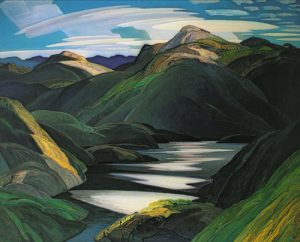The relationship between the darkness we face in both life and meditation, and the light we all so fervently seek.

When I saw these little meditating skeletons ornate with a Santa hat, a whole slew of complex feelings and ideas came to mind, inspiring me to use them for a Christmas blog. I wondered how Coca Cola, Santa, skeletons, meditation, Christ and festivals of light such as Christmas, Hanukkah and Diwali are all connected? Sit down with a tea as I did, as we embark together in reflection, leaving entrenched belief systems you may have at the door waiting.
We all live in this world:
At least in North America, our imagination of the archetype of a saint named Nicholas being kind to children and bring them gifts is inextricably shaped by Coca-Cola. “The Santa Claus we all know and love — that big, jolly man in the red suit with a white beard — didn’t always look that way. In fact, many people are surprised to learn that prior to 1931, Santa was depicted as everything from a tall gaunt man to a spooky-looking elf. He has donned a bishop’s robe and a Norse huntsman’s animal skin .” It was Coca Cola’s involvement that shaped our present North American Santa.
By all accounts, St. Nick’s story begins in the fourth century AD in what is now modern-day Turkey. A man named Nicholas became the bishop of a village called Myra. He was later canonized, and soon became one of the most popular saints in Christianity. That’s about all we know for sure, but much of the folklore surrounding Saint Nick speaks of his kindness and generosity toward children, in a world where those attitudes weren’t easy to find.

Present-day secular and commercial cultural phenomena are all inextricably interwoven into our tens of thousands of years old imagination, and deeply influence our neurofiring patterns and how our brains get shaped and our minds conditioned. Coca Cola represents the multitude of daily concerns and influences that tend to flood our consciousness, get us lost in making mountains out of molehills, and causes us to lose track of what is really important.
Christmas at the time of the winter solstice:
The winter solstice has captured the human imagination throughout the ages and inspired festivities, rituals and religious beliefs across cultural boundaries everywhere. Christmas is just one of those celebrations. History books can easily tell us all about how people’s imagination has digested this time of year with pomp and circumstance of various kinds.
This is the time around the longest night and shortest day, the time when one movement ends and a contrary one begins, where metaphorically new light is born into the darkness. Christ symbolizes not just new hope in a world of suffering, but the new spark of awareness lighting up the darkness of our ignorant autopilot mindless ways of living. We also find this theme of new light illuminating human darkness in Hanukkah and Diwali.
You can find the embodied form of this celebration right now in your breath. Release your tensions down into the earth in the following out-breath, and let go as best you can of all of you into the surrender of the long pause at the end of the out-breath. Remember that one day, on the last day of the form your energy flow took during this lifetime, you will expire one last time before the major transformation of ‘your’ energy flow into new flow patterns. Stay in this pause at the end of the out-breath for as long as it lasts. During those moments of absence of breathing movement, explore with your attention the vast darkness and spaciousness within the grain of sand of just those few moments, having given away all of you as best you could. Lightly rest in this deep stillness of Being that neither calls, regrets nor promises anything. For those few moments, if you have really surrendered all of you to this space where nothing seems to happen anymore, and you don’t need to go anywhere, achieve anything or improve anything anymore, the past and future have both vanished and you can rest in the timeless emptiness you may never have paid attention to before. Wishes, expectations, regrets, and all resistances are gone, and you wait for nothing while being everything. Suddenly, without your doing or planning anything, without a past or cause, from seemingly nowhere, a new impulse emerges from the unfathomable depths of darkness, a new arising from the open and vast potential of emptiness, lighting up your consciousness with a new inbreath, a new form that will unfold through endless cycles of becoming and disappearing, as it has done so countless times before. And time is born again, not for long, even if for an eternity until the next out-breath has expired, for eternity is still imprisoned in time. Thing is – all you need to do is be available for the ride, which means you need to be aware, and when you are aware, you wake up out of time into the timelessness of Being.
We are not of this world:
Not being of this world requires a bit of explanation: It means that we are not who we think we are and what our deluded belief systems want us to see. And so the skeletons are far from macabre!
We are very solidly wired for survival, and evolution has proven how powerful we are in ensuring the survival of our species – so far. Nature and evolution are mainly concerned about creating organisms that can make duplicates of themselves in the most predictably efficient way. Survival of as many specimens as possible under any, even if terrible circumstance, is the name of the game. That should not surprise you: Look around and make an educated guess about what percentage of people live a content, peaceful and serene life without undue worry, unhappiness or suffering; not many! The good life we all so passionately strive for is of no evolutionary concern. For such survival to be ensured, the organism has to be wired in a way as to not be able to interfere with whatever mechanisms it needs to survive. How does nature do that? By wiring organisms as sophisticated automatons with incredible capabilities for adaptation, and in our human case, what is included in the automatism is most of consciousness. Humans are thus automatons believing they make free decisions, when in fact most of their decisions is automatically wired into the system. There is a scientific word for this, and what I am about to tell you is by now recognized scientific knowledge: Human beings are algorithms, and the vast majority of all decisions we make, including what car we buy or what mate we chose, are automatically decided by the algorithm and not by ‘us’. Algorithms are methodical sets of steps that can be used to make calculations, resolve problems and reach decisions. A cooking recipe is an algorithm: You follow the steps and always come up with the same dish. Humans with their thoughts and emotions are just such algorithms – complex calculation automatons that ensure their reproduction and survival. It is both astonishing and humbling to realize how little say we have in ‘our decisions’.
You may now wonder where awareness, liberation, free will and the possibility to reduce suffering come in! Humans are also wired for the capacity to be aware of being aware, or the ability to reflect upon their own experience. However, this capacity is by far not as accessible as you may think, and as I mentioned above, also largely subject to the automatic algorithmic organization of our organism. What this means is that even when you think you are making decisions based on free will, they are mostly not. The decisions we believe we freely make are far more automatic and conditioned by evolutionary wiring and past experience than we ever imagine, and because algorithmic survival mechanisms only afford us a short-term view of reality (how to get food for tomorrow and escape the lion today), our decisions are short-sited and at this stage in our evolution woefully inadequate to ensure the species’ survival. All is not lost though. Through a particular attentional training that leads to the development of mindful states, we can mobilize a potential we are also wired for, and that we did not need with the same urgency when we were roaming the forests and savannas during our hunter-gatherer times. This potential allows us at least to some degree to liberate ourselves from the shackles of the algorithm and make more authentically free decisions with an expanded consciousness that allows us to have an overarching long-term view of the whole. In doing so, we actually broaden the contexts within which we understand reality, and with each broader context we situate ourselves in, reality looks much different than what it looked like when we were imprisoned by a narrow view. We realize we are not of this world, because who we really are transcends our limited view of ourselves as physical organisms.
The skeletons are thus far from macabre! At first blush they are symbols of death reminding us of our mortality. That is only true from the narrow perspective of having identified ourselves with the body as who we are. Who we really are is far more complex than that and transcends this narrow view as I have shown elsewhere. Contemplating our physical mortality has a great silver lining: We tend to take life for granted as we mindlessly sail through its circumstances, as if they were determined, certain and predictable. Reminding ourselves that nothing lasts helps wake up our middle prefrontal cortex for reflection and a more present life. When we look more closely, we are much more than our bodies, and the skeletons become a symbol of timeless being beyond what our blinders allow us to see.
So yes, we are both in this world, but not of this world, as Jesus is supposed to have said, and our skeleton sitting in contemplation during this holiday time of winter solstice is a perfect opportunity to reflect on our lives.
Light and shadow:

Light and Shadow by Franklin Carmichael
This picture of Franklin Carmichael hangs on the wall in our office. It has always inspired me to think about the relationship between the darkness we face in both life and meditation, and the light we all so fervently seek. What is so fascinating to me is how in our attempts at decreasing suffering, we search, strive and struggle to find peace, happiness, liberation or whatever we call God, not noticing that it all is already so naturally there, ready for the taking. When the days get shorter to approach the fall equinox, we mourn the summer; when they get really short to approach the winter solstice, we dread the winter. When they get longer to approach the spring equinox, we pine for spring; and when they get really much longer to approach the summer solstice, we rejoice and forget it will not last. Never are we there where the action is, always wanting something else than what we have or what is.
Now is the time to let nature inspire our fundamental mindfulness principle: Embrace the darkness. Darkness is not the absence of light, but the chrysalis stage of transformation from one energy pattern to another. Darkness means creative fermentation below the visible surface, while everything on the surface seems frozen. Darkness is the lively activity of growth inside the grass we watch and can’t see growing. Darkness is the recognition of blindness before anything else can pierce through it. Like the pause at the end of the outbreath, surrender to it completely. Relinquish all grasping to an old, well worn and familiar view of who you are, and embrace the transformative chaos of the dark. Only then can what’s really novel be recreated and resurrected into a new form, a new temporary identity, like the phoenix rising from the ashes or Christ from the cross. This universal archetypal theme of rebirth is found cross-culturally in many traditions. When we embrace it, learning to ride the phases of transformation from caterpillar to chrysalis to butterfly over and over again without resistance, our transcendent, timeless and nameless Being beyond all cycles of becoming and vanishing radiates through the cloud cover of our ignorance and illusions, as it always has beyond time immemorial.
Much suffering starts with the abhorrence of the darkness, which takes many forms in everyday life. But without honoring the darkness, no breakthrough ever leads to transformation. There is no light without the shadows of its source. The darkness is the fermenting potential, where everything begins, unseen within its protective womb. The deep meditative path is a training in recognizing the call of the dark, and join its source for renewal and transformation. This time of year inspires this introverted orientation towards the stillness of Being.
Copyright © 2018 by Dr. Stéphane Treyvaud. All rights reserved.
Discover how Mindfulness Meditation can inspire »







